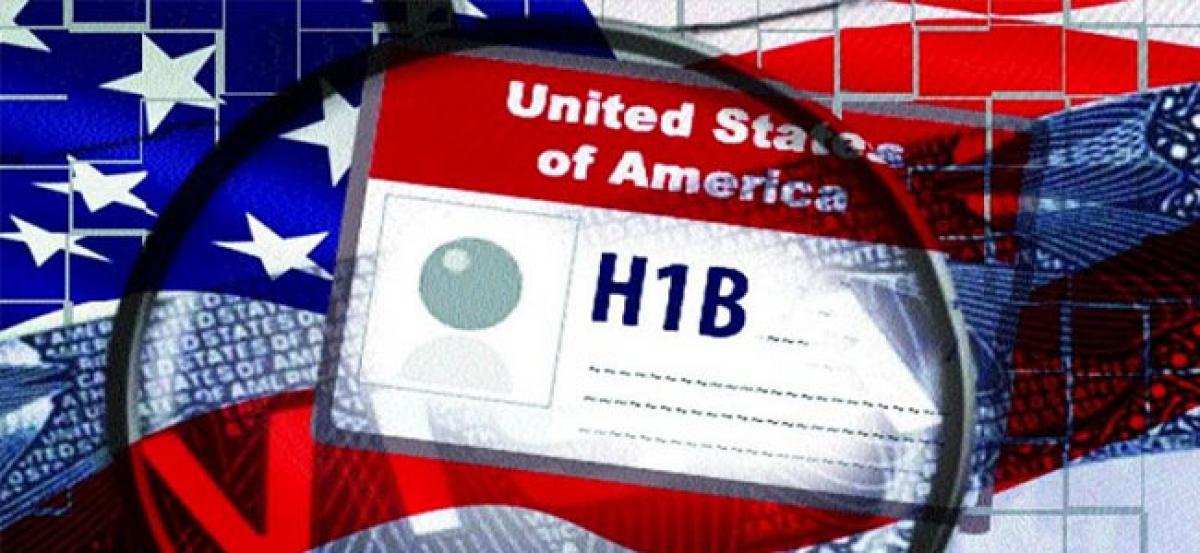Live
- Deputy CM Bhatti Vikramarka Inaugurates Power Substation, Criticizes BRS
- Major Phase in Old City Metro Land Acquisition, Cheques to Be Distributed
- Tragic Road Accident Near Medchal Checkpost: Family of Three Killed, Child Injured
- Road Accident on Hyderabad-Warangal National Highway: One Dead, Five Injured
- Massive Fire Breaks Out at Minerva Hotel in Hyderabad’s Himayatnagar
- PM Modi sets ball rolling for India to become world’s 2nd largest metro rail network
- Sexual assault case: Anna University asks students to use only bicycles inside campus
- Lack of genuine political leadership led to Manipur violence: Apex Meitei body
- Stage 3 restrictions under GRAP lifted in Delhi-NCR as AQI shows improvement
- No room for unmarried couples: Oyo explains check-in policy for partner hotels
Just In

Technology professionals from India accounted for 74.2 per cent of the total number of H-1B visas issued by the US in 2016 and the next year the figure rose to 75.6 per cent, a government report said on Monday.
WASHINGTON: Technology professionals from India accounted for 74.2 per cent of the total number of H-1B visas issued by the US in 2016 and the next year the figure rose to 75.6 per cent, a government report said on Monday.
HIGHLIGHTS
- There has been a drop in the number of new H-1B beneficiaries from India, the United States Citizenship and Immigration Services report said
- China with 9.3 and 9.4 per cent respectively for 2016 and 2017, comes a distant second after India in terms of number of H-1B visas issued
However, there has been a drop in the number of new H-1B beneficiaries from India, the United States Citizenship and Immigration Services report said.China with 9.3 and 9.4 per cent respectively for 2016 and 2017, comes a distant second after India in terms of number of H-1B visas issued.
"The number of beneficiaries from India approved for initial employment decreased by 4.1 per cent in fiscal 2017, while the number of beneficiaries approved for continuing employment increased by 12.5 per cent in fiscal 2017," the USCIS said in its latest report titled 'Characteristics of H-1B Specialty Occupation Workers'.
The H-1B visa is a non-immigrant visa that allows US companies to employ foreign workers in speciality occupations that require theoretical or technical expertise. The technology companies depend on it to hire tens of thousands of employees each year.
The USCIS said petitions for initial employment are filed for first-time H-1B employment with an employer, only some of which are applied to the annual cap. Examples of petitions for initial employment that are exempt from the cap include petitions submitted by nonprofit research organisations or governmental research organisations.
Continuing employment petitions refer to extensions, sequential employment and concurrent employment, which are filed for foreigners already in the US. Extensions generally are filed for H-1B workers intending to work beyond the initial three-year period up to a total of 6 years, the maximum period generally permissible under law.
In 2016, as many as 70,737 Indians received initial H-1B visas, which dropped to 67,815. During the same period, Indians accounted for 185,489 visas for continuing employment, which increased to 208,608 in 2017. In all there were 256,226 Indians on H1B visas in 2016 and 276,423 in 2017.
A copy of the report, sent to US lawmakers on April 10, became public this week.
Dismantling several myths about H-1B, the USCIS said the median salary of beneficiaries of approved petitions increased from USD 82,000 for fiscal year 2016 to USD 85,000 for fiscal 2017.
While the number of H-1B petitions filed increased 1.24 per cent from 398,718 in 2016 to 403,675 in 2017, the number of H-1B petitions approved increased 5.9 per cent from 345,262 in 2016 to 365,682 in 2017.
According to the report the number of H-1B petitions approved in 2017 for workers between the ages of 25 and 34 was 66.2 per cent, the number of H-1B petitions approved in 2017 for workers with a bachelor's degree was 45.2 per cent.
In addition, 44.5 per cent of approved petitions were for workers with a master's degree, 6.8 per cent had a doctorate, and 3.3 per cent were for workers with a professional degree. The number of H-1B petitions approved in 2017 for workers in computer-related occupations was 69.8 per cent, it said.
The number of H-1B petitions approved for workers in computer-related occupations increased by 6.6 per cent from 237,837 in 2016 to 254,592 in 2017. The number of H-1B petitions for all other occupation groups increased by 3.4 per cent from 106,418 in 2016 to 110,009 in 2017, the report said.

© 2024 Hyderabad Media House Limited/The Hans India. All rights reserved. Powered by hocalwire.com







